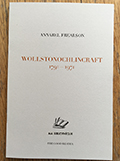Wollstonochlincraft 1791-1971
Wollstonochlincraft 1791-1971 forges compound neologisms from two emblematic feminist texts that are mirrored in their dates and message: A Vindication of the Rights of Woman (Wollstonecraft, 1791) and Why Have There Been No Great Women Artists? (Nochlin, 1971). Their historic argument recursively resonates within a digitised neoliberal realm to reflect our contemporary reality and dystopian future trajectory.
Linda Nochlin herself has kindly selected the words for inclusion within this publication produced by Sharon Kivland as part of The Good Reader Series.
To purchase a copy of the booklet Wollstonochincraft 1791-1971 published by MA BIBLIOTHEQUE go to: http://lightsculpture.pagesperso-orange.fr/sharon/publications.html




Introduction
1791 ~ 1971
A mirroring of dates and messages: the first from Mary Wollstonecraft in A Vindication of the Rights of Woman (1791), followed nearly two hundred years later by Linda Nochlin in Why Have There Been No Great Women Artists? (1971). The message is unambiguous: without the same freedoms and education as men, how can women achieve greatness? It is a structural and foundational issue; as foundational as language.
Wollstonochlincraft 1791-1971 forges compound neologisms from these two historic texts to reflect on our contemporary reality and dystopian future trajectory. Born of an atavistic recursivity within a digitised neoliberal realm, these bastards proliferate and gain traction.
1791 saw the peak of Romanticism, a period of absolute subjectivity and parsing of the world through the imagination. 1971 heralds the birth of neoliberalism and the digital age, marked by the Nixon Shock and creation of the relational database. Both post-revolutionary periods offer the illusion of freedom and mass productivity of individual expression through language, aesthetics and, now, data (what I have elsewhere called 'infomanticism'). Like the Fountains of Glory, however, this represents a sublime regurgitation of the same content, albeit in dazzling new configurations. While we are amused by our creations, the ideological infrastructure remains the same. Worse still, freshly packaged, it sells itself back to us.
Having promiscuously generated over 60,000 compound neologisms from conjoining these emblematic texts by Wollstonecraft and Nochlin, I pre-selected a list of resonant words. By invitation, Linda Nochlin herself has generously made a further selection, presented in this publication. I thank her with deep respect and gratitude.
Annabel Frearson, April 2017
